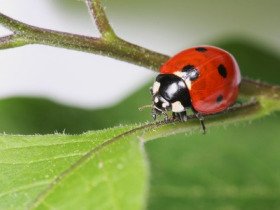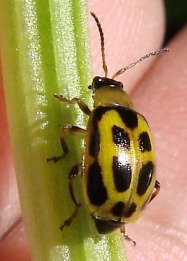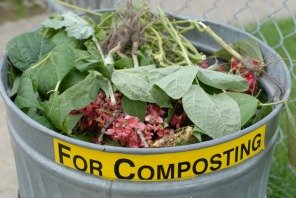Vegetable Garden Pests
For the beginner gardener tackling the problem of vegetable garden
pests can at best seem totally confusing and at worst just plain
overwhelming.
Whether you're an experienced gardener or a beginner gardener
just getting the hang of your green thumb, vegetable garden pests are an unavoidable reality in the gardening world.
Many a beginner gardening enthusiast has told me of their frustration watching their vegetable plants first begin to grow healthy and then be eaten away like their confidence by ferocious garden pests gorging themselves on young plants without so much as a thank you.
And if you think that's bad enough, wait until you review the mountain of information on the internet to do with insect and pest control. To put it mildly, "it boggles the mind!"
Now don't get me wrong, there is a fantastic amount of information out there (but be careful as some Web sites are full of misinformation) just waiting for you to come-a-calling with solutions for just about any vegetable garden pest your plants may encounter. The operative word here is "any vegetable garden pest."
After reading a few excellent articles it won't take you very long to say "wait a minute," there seems to be hundreds of pesky pests and volumes of information on how to recognize and get rid of them." Oops! "Information overload!"
To save you the laborious task of sifting through all the information available about vegetable garden pests, I decided to condense this subject into what I hope is an easy read addressing the most common garden pests your vegetable plants may encounter.
I'll start with a general overview to keep continuity and use links to identify specific insects.
Okay, that said, I suggest you read the article in its entirety to better understand the trouble and damage these "pesky critters" can cause and then click on any or all links to identify a particular insect.
All set? Then let's begin.
Types of Vegetable Garden Pests
Generally speaking, vegetable garden pests can be categorized into three categories:-
- Pests that eat leaves and other plant parts
- Pests that get their food source from the sap of plants
- Pests that live in the soil that feed on plant roots and stems
Don't forget to visit My Gift Shop
before you move on :)
After browsing my Gift Shop, you will see a link that will take you back here where left off reading.
The Good Critters


Before I go any further and for "clarity" sake, please note that not all insects in your garden are vegetable garden pests. The majority of insects roaming around your vegetable garden
have no interest in your plants; they're just part of the neighborhood.
And there are other insects like spiders, ladybird beetles, lacewing, praying mantids, also known as praying mantises that are good critters and are your vegetable plants best friends. These "good critters" protect your plants by eating insect pests, aphids, and other plant pests that seem to exist for the sole purpose to devour as much of your vegetable plants as possible.
The Bad Critters


Now let's look at each variety of vegetable garden pests as listed above in our category breakdown.
Pests that eat leaves and other plant parts-
These vegetable garden pests are easy to identify because they leave a distinct trademark. When you inspect your vegetables you will easily notice holes in the leaves
left from their work. These garden pests use their mouth parts to tear off plant tissue chomping away for a great meal.
With the exception of the ladybird beetle and lacewing, these nasty insect pests include a beetle pest, flea beetles, tomato hornworm, cabbageworm, as well as other plant pests and insect pests just to name a few. I call these critters "chompers," because they are constantly chomping away on plant leaves.
Vegetable garden pests that get their food source from the sap of plants-
These are the piercing, sucking variety of pests that cause vegetable plant damage by piercing and sucking liquid from the plant or fruit. The most common of these vegetable garden pests are aphids, thrips, spider mites, stink bugs and squash bugs. Vegetable garden pests that live in the soil that feed on plant roots and stems-
These pests are the most difficult to control because you can't see them, but rest assured they are there in the soil or soon will be after you plant your seedlings. Unfortunately, because they usually live in the soil they are pretty much left alone when it comes to predators. Some of these pests worth noting are mole crickets, southwestern corn borer, pillbugs and sowbugs.
Pest Control Management
Much has been said about the pros and cons of pest control management and the debate still goes on by gardeners about which is the best method to use for vegetable gardening. It pretty much boils down to whether you prefer
organic gardening or use synthetic chemicals.
Before we discuss both methods of gardening, let's take a neutral position concerning pest control maintenance. Some gardeners may even say "these tips I'm about to offer are part of what organic gardening is all about." Well that's fine by me, and for the synthetic chemical gardener then you'll have it both ways.
- Choose plants recommended for your area that are resistant to local pests. This is a tall order (and I know of none) but some gardeners insist they have had success using this approach. For that reason only, I made note of the above suggestion.
- When purchasing plants, carefully check each vegetable plant to make sure they are pest free. Routinely inspect your garden plants for visible pests and handpick any you find.
- Use a cardboard collar for pests such as cutworms that hide in soil especially if you plant cabbage, peppers and tomato plants.
To make a cardboard collar, cut a piece of cardboard in a 4 inch width and wrap around your plant stem at planting time. The collar should be 2 inches below and above the soil, and it makes a great barrier against invading pests. If you're planting cabbage, place a small section of cardboard at the base of the cabbage on top of the soil to prevent the cabbage maggot fly from depositiong eggs. - If you live in an area that has a rainy season, place a saucer of beer nearby to attract snails and slugs to the beer where they will climb in and drown.
- Sticky Traps will do a great job keeping the sucking insects population down, but remember to replace the trap when necessary.
- Use a direct stream of water from a garden hose to remove eggs as well as spider mites. Use this method early in the morning to give your plant leaves a chance to dry off. You don't want to encourage a fungus to develop.
- Keep your garden neat and clean. Not only will it look nice it will also dispose of dead unwanted plants that usually harbor pests.
- Keep a written record of what worked last year, and do the same when planting next year's crop.
With a little work and diligence, most of your vegetable garden pests will be reduced in number so they can be managed by other methods of pest removal.
Should I go Organic or Synthetic?


The the first question may be "what is the difference?"
Organic gardening
In its broadest
term could mean a method of gardening using mostly living things, (an example would be a compost pile) and other environmentally-friendly methods. It could also be said organic gardening is working in harmony with nature and excluding the use of synthetic insecticides.
Insecticides
Extracted from plants or derived from nature are generally accepted as an organic method of gardening. Some examples of botanical insecticides include neem extracts, pyrethrum and B.t (a bacterium that attacks caterpillars).
Other acceptable sources include insecticidal soaps (especially useful for control of aphids), vegetable oils, mineral oils, and sulfur dusts.
Also accepted for use by organic gardeners is silicon dioxide used for control of insects, slugs and snails, but once it gets wet it becomes compact thereby loosing its ability to be an effective pest deterrent.
Unfortunately, these organic methods are at best, moderately effective in killing vegetable garden pests and detrimental to our "good guys" the beneficial insects. The good news is these organic insecticides have a low toxicity to humans and pets.
But be aware!
There are some botanical insecticides that do not guarantee they are non-toxic. So please do your homework before you use botanical insecticides as they can actually be much more toxic than some synthetic chemicals commonly used in the garden. Always read the manufactures label as well as ask a Nursery expert or your local agricultural department about their toxicity before you use any of these products.
While on the subject of organic gardening and pest control, many vegetable gardeners say they have had great success using companion gardening to keep pesky insect pests under control. It has worked for me in reducing garden pests and I encourage you to give this organic method a try in your garden.
Synthetic Insecticides
Are materials that have been synthesized from specific raw product and are usually thought of as chemical in form. Examples of synthetic insecticides include: Malathion, carbaryl, and diazinon.
Much has been said about the use of synthetic chemicals on crops and usually not very flattering. While I am not here to say whether you should choose synthetic chemicals for your garden or use an organic method (I'll leave the decision up to you), I do know that both methods are practiced in the gardening world and deemed FDA safe. If you visit any supermarket you have the option to purchase your produce grown by both methods. That said ... Here is a little note worthy of your attention.
Pesticide and insecticide
Are not interchangeable words or are they in meaning.
A pesticide
Is any chemical control one would use in the garden. On the other hand, an insecticide is actually a pesticide used in the control of insects which we in this article consider to be "vegetable garden pests."
Another term we hear quite often is herbicide
Which is a pesticide used to control weeds.
Be careful if you use this chemical form in your garden because if you accidently use an herbicide on your vegetable plants, you'll lose your entire crop. Yep! It will kill them dead.
Again and always worth mentioning before you use any product, always read and follow the manufacture instructions.
When using synthetic chemicals, be sure to use only the amount required and use only on the specific infected vegetable plants. Know the vegetable garden pests you are dealing with and on what crop they invade, then check the label to make sure you are using the correct product.
If you have tried non-chemical insecticides on infected plants without success, consider using a synthetic chemical that is least harmful to the environment to control the pest insect. And remember, when you set out to control harmful pests, it's important to realize that indiscriminate use may destroy not only insect pests but also beneficial insects. That is to say ... "your good critters."
As always in any of our articles regarding insecticides, safety should be your greatest concern.
To read more about common sense rules on pesticides take a "safety moment" and scroll down to the heading "Safety Precautions" in our garden weeds article.
Great! Now that you have an overview about vegetable garden pests, be sure to click on any link of interest for more information and pictures about these "nasty critters."
We hope you have found this article on vegetable garden pests informative and interesting.
Our thanks go the the following websites for their excellence and informative information, and which we have placed a link to enhance our readers knowledge.
They are in no particular order:
CSU/Denver County Extension Master Gardener, The Department of Horticulture, Bug World, Forestry and Recreation Resources Kansas State University, University of Illinois Extension, and University of Rhode Island Landscape Horticulture Program.
Before you leave me why not drop in to My Gift Shop for a peek and see if you find something of interest for you, family, or friends.
As always,
Happy Gardening
Return from garden pests to Growing a Successful Vegetable Garden
Copyright © 2008-2019 All rights reserved.

